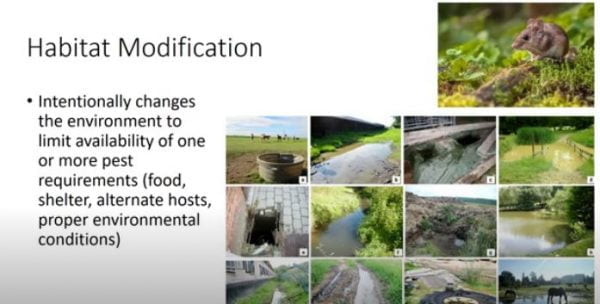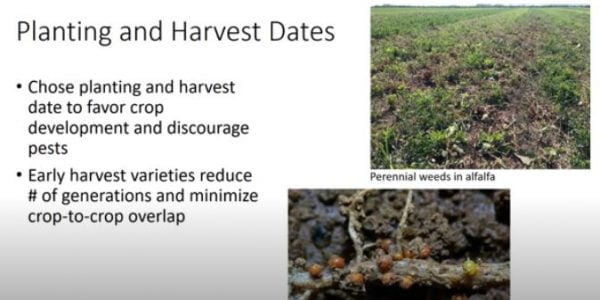Table of Contents
Introduction of Cultural / Garden Pest Controls
Are you Suffering with Crop or Garden Pest?. Sometimes we can use Cultural practices as pest prevention tips, natural garden pest control, to change / modify / adjust the environment, which will make it less favorable to pest reproduction, invasion, survival or infestation. For Example, A simple change in timing of water irrigation will lead to less weed germination or disease incidence. A simple change in harvesting or planting time may allow a crop to escape pest infestation or invasion.
Cultural / natural Garden pest controls complement other control options, and are an essential component of IPM programs. Cultural / natural Garden pest controls are generally familiar, simple, and inexpensive, and they can often be incorporated into management systems with only minor modifications.
Cultural / natural Garden pest controls is most often used as a preventive pest management tool to properly implement cultural / natural Garden pest controls measures. It is essential to have a good understanding of crop and pest, biology, ecology, and phenology, with special attention to weak links in the life cycle of the pest.
In this Article I will go over the different types of cultural / natural Garden pest controls practices. Such as,
- Site Selection.
- Sanitation.
- Destruction of Alternate Host.
- Habitat Modification.
- Trap Cropping.
- Planting and harvest Time.
- Irrigation and Water Management.
- Fertilizers and soil Amendments.
Cultural / Natural Garden Pest Controls Practices
Site Selection
Sometimes Garden pest problems can be prevented,
- By selecting a site that is pest free.
- By choosing a crop plant species or variety that is particularly well suited to the site.
- Before planting evaluate, whether the site and the resource being planted are profitable match, or whether the combination will create or aggravate pest problems? For example,
- Trees or shrubs are often planted in landscapes without regard to the environmental conditions favorable to that plant.
- Azaleas planted in poorly drained, heavy clay soil will not perform.
- Plants poorly adapted to conditions at there site are more prone to insect, disease damage, and generally do not perform well, Such as magnolias planted near the ocean.
Likewise, it is a good management to avoid fields with weeds that are potentially troublesome and hard to control in a crop, instead plant an alternative crop where available herbicides, cultural practices, or crop competitiveness, will help reduce troublesome weeds.
Sampling, for nematodes, propagules of potentially damaging pathogens, weed seeds, and looking at the field history, prior to planning can help determine whether the site is suitable for given type of crop or not?
Sanitation
Sanitation is an important management tool, natural Garden pest controls method, that is applicable in nearly every habitat for most kinds of garden pest, and also to control pest infestation in food business. Good sanitation practices minimize Garden Pest, by removing or destroying their breeding, refuge, over wintering sites, or the pest species themselves.
For instance, some plant pathogens cannot survive without a plan host; removal of all residues from previous crops can limit future infestations.
Some sanitation practices are effective enough that they eliminate the need for pesticide applications. For example, removal and destruction of mummy nuts from almond trees, eliminates the overwintering sites of the navel orange worm.
Important Sanitation Techniques For Cultural / Garden Pest Control
Important sanitation techniques for reducing garden pest includes
- Use certified, seed, tubers, or rootstock, to prevent the spread of, nematodes, weed seeds, and viral bacterial and fungal pathogens, that may be carried in contaminated plant material.
- Thoroughly clean with steam or pressurized water all equipment’s as it moves between different sites to prevent the spread of, pathogens, nematodes, and weeds.
- Use clean irrigation water – do not irrigate with tail-water from fields infested with root knot nematodes or other soil borne pathogens or pests.
- Do not use water that may carry runoff containing harmful herbicides.
- Install screens in pipe bringing irrigation water from canals or ditches to filter out seeds, rhizomes, or other weed parts.
- Remove or clean up unharvested crops or areas that might provide over wintering habitat for pest.
- Eliminate weedy borders.
Destroying Alternate Hosts
Destroying alternate hosts can effectively suppress certain pest populations. For example, some weeds and other plants act as alternate hosts for insect and pathogen pests. Destruction of these reservoirs can aid in suppressing pest populations.

More Examples and tips to keep bugs out of garden, kill garden pest, natural Garden pest controls are as follows,
- The control of curly top virus in Sugar beats involves the destruction of weeds that are alternate host of the beet leaf-hopper.
- lettuce root aphids overwinters in galls on poplar trees. Lettuce growers have successfully reduced populations of those aphids, below damaging levels in their fields, by eliminating poplar windbreaks.
- For apples, a fungus, apple-cedar rust, requires two host for survival, the elimination of cedar trees nearby apple trees can reduce the disease.
Habitat Modification
Pest problems occur when conditions essential for survival, that is food, shelter, alternate hosts, and proper environmental conditions, are favorable for garden pest.
Habitat modification intentionally changes the environment to limit availability of one or more of these requirements, thus reducing the suitability of the host to pest populations. Habitat modification is very important in Cultural / garden pest control.

For example,
- Weeds, ground cover, and litter, provide food and cover for field mice. Eliminating these areas in and around, crops, turf, and landscaping cultivated areas, reduces the potential of these areas to support these and other vertebrate pests.
- Habit modification is effective in limiting numerous insect pests as well. For example, draining areas containing standing water reduces breeding sites for mosquitoes and is an important management technique.
Trap Cropping
Trap cropping uses plants attracted to insects or garden pests to lur them away from the Cash Crop. Trap crops provide many benefits including, increasing crop quality, attracting beneficial insects, enhancing biodiversity, and reducing insecticide use.
How to Plant Trap Crops To Control Cultural or Garden Pest?
Trap crops can be planted around field parameters or inter-planted with the cash crop. A trap crops effectiveness depends, on what Cultural or Garden pest, you are trying to manage?, and how desirable the host is for those garden pest.
- The trap crops should be planted at least 2 weeks before the main crops since the reproductive structures (the flowers and seeds) are the main attractor.
- It is best to use multiple trap crops and stagger them so that pest don’t move off of the trap crops.
- For early spring cash crops, plant triticale in the fall for stink bugs.
- Sunflowers, buckwheat, sorghum, and millet, are recommended for the summer to fall period.
- For protection from the harlequin bug in Cole crops, mustard can be used.
Planting and Harvest Time is important in natural Garden pest controls
Planting and harvest date should be chosen to favor crop development and discourage cultural or garden pest.

- For weed management: choose a planting time that favors the germination of the crop over key weed species. For instance in many parts of California,
- Fall alfalfa planting can be adjusted to avoid both, late germinating summer weeds, and late fall germinating winter weeds.
- However, crops planted too late in fall will germinate and grow slowly, allowing winter weeds to become well established.
- In fields that are infested with field bindweed, perennial grasses, or nut-sedge, planting in early fall will ensure that alfalfa’s establish and growing when these perennial start growing in spring.
- Adjustments in timing of planting can also aid and insect and disease management. For Examples, Winter grown carrots and potatoes can be planted when the potato cyst nematode is not active, avoiding exposure in early crop development stages when the pest is the most damaging.
- Harvest can also be timed to limit or avoid pest damage. Early harvest varieties reduce the number of generations and minimize crop to crop overlap in some crops.
Irrigation and Water Management
Poor water management is a major contributor to many garden pest problems.
- Excess salt water excludes oxygen that plant roots need to survive, and is a primary factor in the development of many written crown diseases, such as phytophthora root rot.
- Excess water, poor drainage in low areas of fields or landscapes also favor numerous hard to control weeds, such as nut-sedge and barnyard grass.
- Under watering, or drought stress, on the other hand, may cause wilting, sunburns, sun-scald, and branch cracking that can allow invasion of pathogens and attract boring insects or it can stress plants to the extent that they cannot overcome attack by pests. this is specially true of conifers.
- Certain types of irrigation systems are both positively and negatively associate with pest populations. Droplets from overhead irrigation can dislodge, drown, or drive some insect mite pests and reduce powdery mildew, but it can also encourage fruit and foliar diseases.
- Drip irrigation systems deliver water only to sites, where it is needed, reducing diseases and weeds.
- To avoid problems associated with over or under watering, learn the water requirements of the plants, and learn how much water the soil can hold.
- Schedule the frequency and amount of your irrigation using weather based methods or by measuring soil moisture.
Fertilizers and soil Amendments
Fertilizers and soil amendments are applied to promote, healthy plants, and increase yields. Although not a pest management practice, the use of fertilizers, and soil amendments, can influence the activity of many garden pest species to the advantage or detriment of the host plant.
It has been argued that healthy plants have a greater tolerance to pests attack and damage, while this may be true, over fertilization may attract or enhanced development of many pest species.

Cons of Using Excess Nitrogen are,
- Excess nitrogen on nectarines, for example, results in increased levels of brown rot, oriental fruit moth, and peach twig borer.
- Excess nitrogen levels are also contributing factor in the incidence of large patch, a common disease in Saint Augustine-grass.
- Aphids, leaf-hoppers, lace bugs and other sucking insects are socially with the lush growth that results from excess nitrogen application.
Adding the proper amounts of soil nutrients when the plant needs them greatly assists pest management practices and limits environmental contamination from excess nitrogen, especially nitrogen loss from leaching to groundwater.
in conclusion this articles went over the various types of cultural or garden pest controls and can be used as part of an integrated pest management program.
